|
Biohazard
suits in the past
Please click on a picture to
enlarge
and read the Copyright
notices, that I gathered here.
Of special interest to me are similar cults and
rituals that are found in ancient cultures all over the world.
Especially cultures that established archeologists say had no contact
with each other.
One of those rituals and cults is a strange one that usually puts a big
smile on modern time observers. If you look only superficially there
seems to be not much mystery to this cult, but at a second glance it
looks a bit different.
In 1908 archaeologists
found near the Austrian town
of Willendorf some figurines that are among the oldest depictions of
human beings ever found. The figurines are more than 25000
years old and depict rather obese naked females. One of the
figurines became
famous under the name of “Venus of Willendorf” (See photo on the right.
Photo source: Wikipedia Commons; Author: Matthias Kabel). The term
“Venus”
derives from the Renaissance were it was used to show an ideal body
type of an era. Problem solved?
Not quite!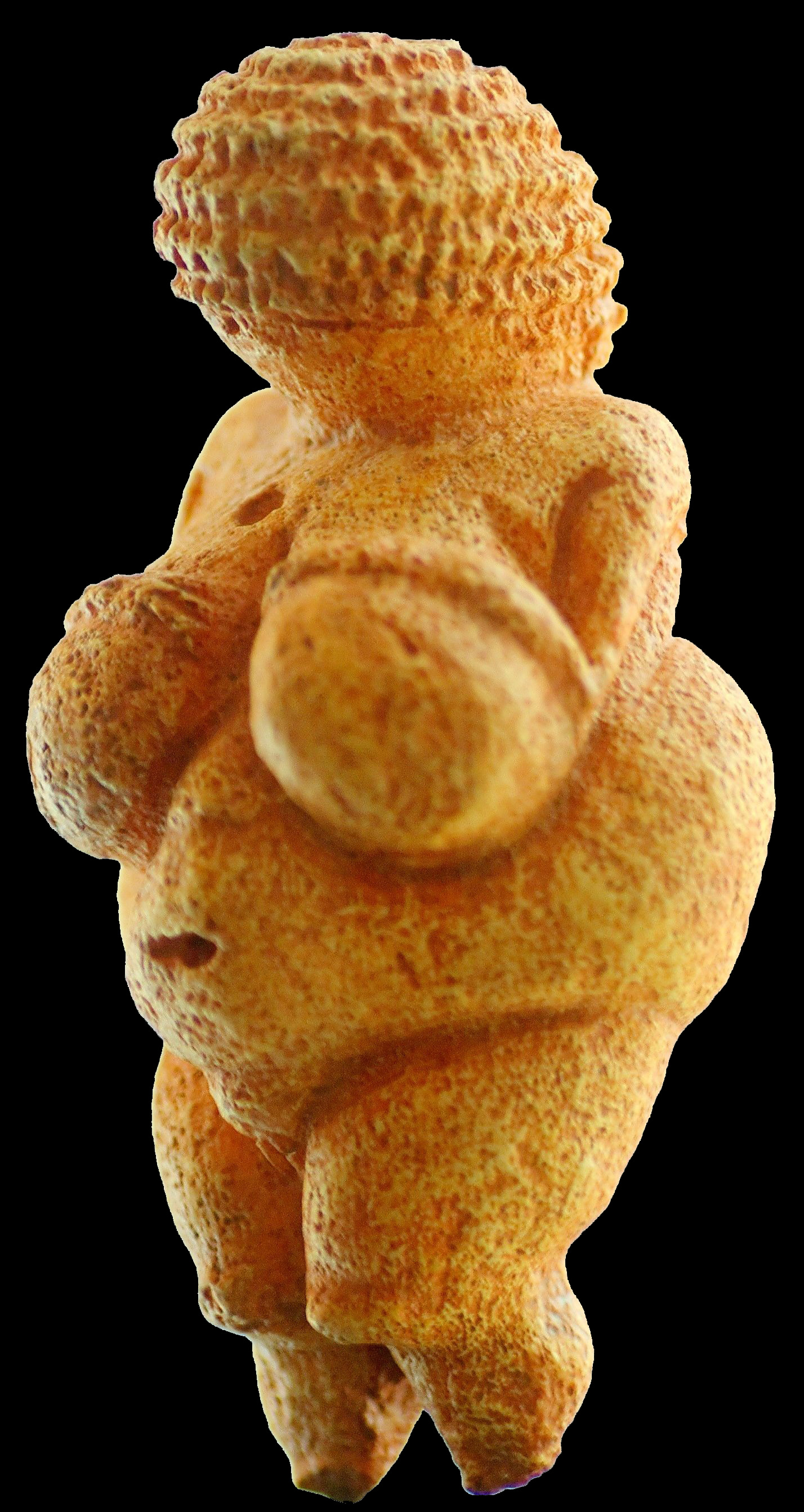
The figurines have one peculiar feature (next to
the body being shown as obese). While the body is shown in integrate
detail, the face is usually completely without features. We know just
by looking at the figurines, which the artist would have been perfectly
capable of showing the face just in as much detail, but it is obvious
that the artist(s) specifically chose not to.
If we go back 25000 years, societies were much
different compared to today. In our modern world we see many obese
people, especially in the western world were fast food and lack of
exercise contribute to obesity. In fact, obese people became such a big
part of our society that we don’t think twice about it if we see those
old figurines in museums.
If anything, modern onlookers get a giggle out of
them. “Aha, they liked big girls back then…”
While there is certainly some truth to the above sentence that obesity
might have been considered beautiful, the question remains on
why.
As mentioned above in our modern world we have no
problem finding obese people. Our lifestyle and food choices contribute
significantly. On top of everything many of our foods are processed,
loaded with sodium (that we take for granted to be easily available),
preservatives and last but not least the lack of exercise contribute to
our society’s obesity problems.
But how did that look 25000 years ago? We have to
think back to a time long before the last ice age. I time we know very
little about. What we do know, is that the society back then was that
of hunter/gatherers.
Those societies are not especially known for their
plentiful food supplies and over-the-top superfoods* with plenty of
nutritional values. Chocolate milk and cookies, cheeseburgers and other
fattening goodies where not known back then.
That’s why hunter/gatherer societies have to be
very efficient with their foods.
Food preservation was limited to drying fruits and drying (jerking) and
smoking meats. Everything else had to be consumed swiftly.
Like in hunter/gatherer societies nowadays, food is
always at a premium. Hunting was hard work and dangerous 25000 years
ago. If we look at the few hunter/gatherer societies that are still
left nowadays, obesity is certainly not a problem.
One explanation could certainly be that obese
people – especially women – where considered “something special” in
those societies and where especially “made” as depicted in the
excellent movie “Quest for fire” from 1981. But even then with the
foods available at the time it would have been not an easy task to
“make” obese people. At all times there were certainly people with a
tendency to get bigger than others. Also certain cultures seem to have
a tendency to be more “substantial” then others. The natives of
Polynesia for example are overall bigger as natives in other parts of
the world. This has certainly to do with food sources that are more
easily accessible. To obtain food on evergreen tropical islands is
certainly easier as in tundra that is snow covered 5 months a year
But this does not explain why those people were
considered “special” or “god like”. What triggered this “cult” or the
obsession with obesity? Was is it that humans always strive for the
unusual, the un-obtainable? Certainly possible as it could be argued
that nowadays many people see it the other way around if you look at
the cover of magazines for the “high society”.
.
I would like to offer a different explanation as
“the cult of the obese” as I call it was not only present in ancient
Europe, but can be found in ancient cultures all over the world. And as
you probably know by now - if are a frequent visitor to this site –
worldwide cults and “obsessions” in ancient and prehistoric times are
of great interest to me
First I have to show you what I mean by “worldwide
cult of the obese”. As I said above the oldest depictions of this is
the Venus of Willendorf.
But many variations of the same theme exist, like
below in Ecuador and Japan. I'm fully aware that there is a huge time
difference between those artifacts and I address this question on my Frequently Asked
Questions page, Question 18.
The figurines are very interesting as they show a
very strange body anatomy. You see that the shoulders, arms and legs
are depicted extremely large, while the mid-section of the body is
relatively normal. Another strange feature is the elongated head (see
my separate article about deformed skulls all over the world) that
looks like it is wearing a helmet. Curious are also the slit like eyes
that lack pupils.
I want to draw your attention once again to the enormous shoulders and
“slit eyes” on the Ecuadorian figurines and compare them to the famous
Dogu figurines from Japan:
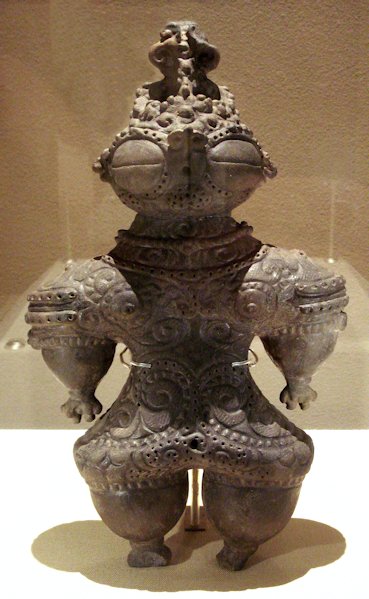 Source Wikipedia Commons. Author: World imaging Source Wikipedia Commons. Author: World imaging |
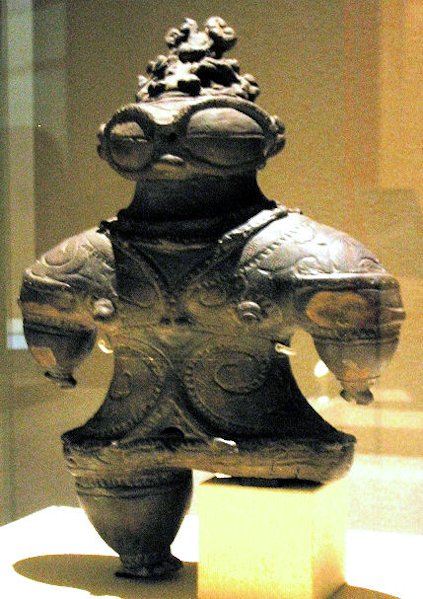
Source Wikipedia Commons. Author: PHG |
Now, the Dogu figurines of Japan are known in
PaleoSeti research for many years. Those amazing figurines are probably
the finest depictions of misinterpreted technology . Even if you are
not a Ancient Astronaut theorist you can see the very technical looking
suits and helmets.
In the past the suits where interpreted by many
PaleoSeti researchers as space suits of extraterrestrials. But there is
a logical problem with this interpretation. Here on Earth you don’t
really need spacesuits, especially as the ancient texts tell us that
“the gods created us in their likeness”. On top of that the ancient
texts speak of the gods interacting with humans in a way that really
contradict the cumbersome looking suits depicted on the dogu figurines.
If they were not space suits, what is shown? Diving
suits? I don’t think so. If you look at the Dogu figurines above they
look indeed a bit like an old fashioned diving suit from the 1930s. But
even our technological standard from today exceed these cumbersome
things by far and we can assume that extraterrestrial visitors are at
least of own technical standard.
So what do the figurines depict you might ask and
what does it have to do with “the cult of the obese”?
Five years ago I was tired of doing the same thing
over and over in my day job and I decided a career change was in order.
My wife works in a Biological laboratory for many years and I thought
this would be an interesting venue to pursue. During this change I had
to learn about the different PPE (Personal Protective Equipment) that
are available to staff working in environments with bio hazardous
materials. There are several levels of PPE ranging from simple gowns,
gloves and safety goggles to full body biohazard suits. The highest
level of protection are the so called Level 4 containment suits. Those
biohazard suits have to be pressurized with positive pressure. This
means they are inflated for the simple reason that if something
punctures the suit, air streams out of the hole and microbes can’t
enter the suit. Here are some examples of suits like this:
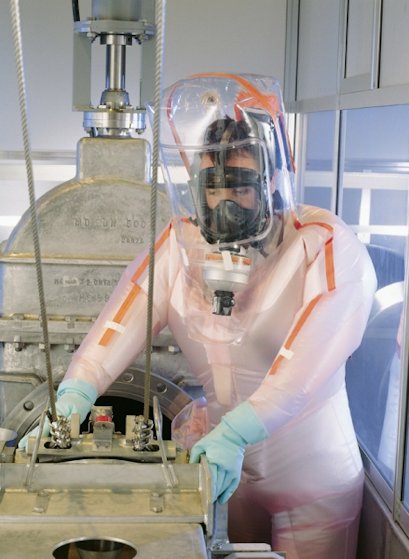
A pressurized Biohazard suit. Courtesy: Honeywell safety products |
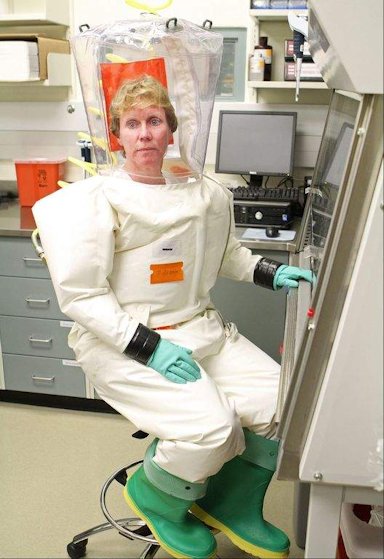 A pressurized Biohazard suit. Courtesy: gazette.net A pressurized Biohazard suit. Courtesy: gazette.net |
Please note that because of human anatomy the
section around the shoulders and arms look especially big and inflated,
just like we see in the ancient figurines from Ecuador and Japan.
Why would extraterrestrial visitors wear Biohazard
suits? I think this answer is obvious. The worst threat for anybody
visiting a new biological environment are microorganisms that the body
has no defence for. We know from history that isolated Native Americans
for example had no defence for diseases that were brought from Europe.
The small pox pandemic nearly annihilated whole tribes of natives.
One would assume that anybody that visits a
different planet would proceed with outmost caution before conclusive
research can be done to make sure the environment is safe to work and
live in. Also new crew members that arrive for the first time on the
planet would be quarantined first and a biohazard suit is the best
method for this.
The design of an effective biohazard suit is pretty
much determined by its purpose. So if you want the best security
possible, you will HAVE to pressurize the suit. That’s true now and
will most likely be the case for future models.
So what does all of that have to do with the “cult
of the obese” as I outlined above?
Imagine you live in the Stone Age and have not the slightest idea what
a biohazard suit is, how does the above photo look to you. Especially
if you only see those “being” from far away. They would indeed look
like overweight humans. The Natives would certainly realize that those
beings are not from here as they use strange, unknown tools and
equipment. But the most important trait of the beings would be their
physical appearance. Later, when the strangers left already, a cult
developed and the people wanted to look and act like those 'gods' they
have witnessed. The 'gods' were big and bulky, so that was considered
beautiful.
Of course all cultures a bit of variations how they imitated their
gods, their suits and technology. Here some variants from Africa that I
photographed in the Metropolitan Museum of Art in New York:
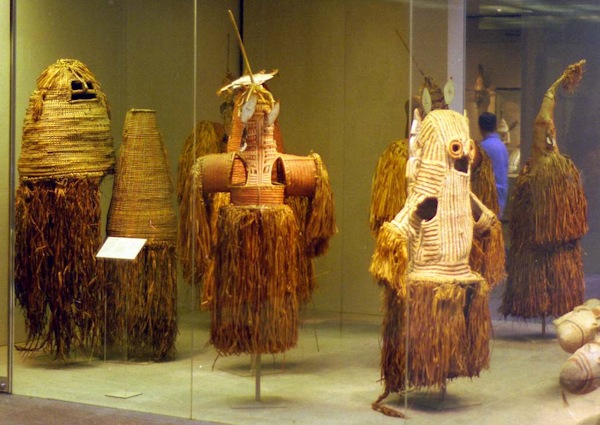
Those biohazard suit copies
from ancient times can be seen in the Africa section of the
Metropolitan Museum of Art in New York. They are much lesser known as
their South American counterpart from Brasil. There, deep in the
rainforest the tribe of the Kayapo celebrate a yearly festival of their
god "Bep Kororoti". This was discussed many times in the Ancient
Astronaut Literature and is therefore found many times if you do a
Google search. Bep Kororoti gained the public's attention after the
1973 movie from Germany "Chariots of the Gods" that is made after the
book with the same name of Erich von Daeniken.
| On the left you see an earlier
depiction of Bep Kororoti from 1952. In reality all of the depictions
all around the globe are a variation of the same theme. They all look
slightly different of course as the individual cultural influences went
into the depitctions. But it is my strong believe that they all have
the same source. |
|
If we
continue on and think about this rationally, we can assume that if
Biohazard suits where used in certain areas of the world, lesser
protective equipment was sufficient for other areas. This is the same
in modern biological testing facilities were several stages of personal
protective equipment (PPE) is used. In
El Baul, Guatemala, A strange stele was found during archaeological
excavations. Erich von Daniken in his book xxxxxxxxx [] first presented
it to the public. The carving on this stele shows a strange scene: A
figure is standing prominently over another that is laying down. In the
hands this figure holds two round objects. The most interesting part of
this carving is the head area of the figure. The person wears a helmet
that the artist carved in shape of a jaguar. You can clearly see the
snout. In front of the snout you can see what looks like a flame
coming out. It's clear that it is a helmet as the eye and the begining
of the nose of the figure is visible through the round hole of the
helmet. The most curious thing is the hose that runs from the helmet to
a box that the figure wears on its back. 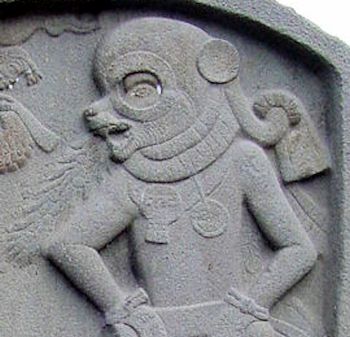
| 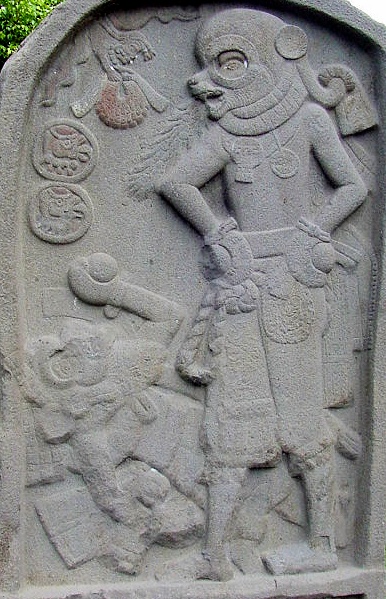
On the left you can see a detailed shot of the helmet, the hose and the box. |
For
archaeologists this stele is nothing else but the depiction of a Maya
ball player. The Maya had a ritualistic ball game were the loser often
faced death. Archaeology says the ball player depicted was victorious -
hence standing - over the other player laying down. The player was
crowned with a Jaguar mask and the box on his back is a depiction of a
Possum. But I believe, we have to look closer and see the carving with
technical eyes. My wife and myself work in a biological Laboratory that
detects all kinds of pathogens that are a threat to public health. Some
of these pathogens are highly infectious and of course we have to
protect ourselves with state-of-the-art personal protective equipment.
The photo on the right shows such equipment worn during a regular work
day. You see the protective hood of the head that is connected with a
flexible hose to an air-purifying unit that can be worn on the hips as
shown on the back if the person stands up. The air-purifier
re-circulates the air and cleans it with a filter. There are different
models of this filtration system available and some feature an outlet
valve for air in the front just like modern gas masks have. I would
like to point out the incredible similarity of the modern equipment and
the technology that has been depicted on the ancient Maya Stele from
Guatemala.
I woul also like to point the attention to the
flame-like carving on the stele above. There is also a very simple
technical explanation for it. Some devices produce produce condensation
during a humidifing process. This could happen because of an
significant difference in humidity or - as everybody knows during the
winter months - temperature. This effect is seen even in warm
surrounding temperatures as can be seen in modern household
humidifiers. I think it's pretty clear that the above stele is one
of the best examples of misunderstood technology. The artist carved
exactly what he saw, remembered or what was described to him, in
amazing detail and precision and if we look at the ancient stele with
modern eyes, it makes sense.
Or maybe we go with the Possum... You decide!
|  |
|

